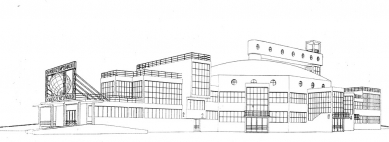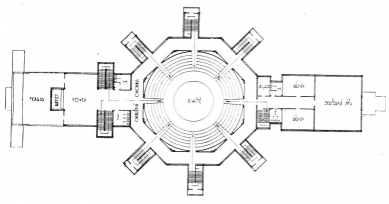
Project of the Liberated Theatre

On the Universal Stage
The sketches of the new theater by architect Chochol, to which I add these few words, in which I have only modestly participated in the conception, point to new efforts to redefine the theatrical space of the Liberated Theater.
The new perspectives of the Liberated Theater are closely linked with the construction of the theater and the installation of the stage; the newly discussed theatrical-material problems reveal the one-sidedness of existing theater buildings, whose Renaissance standard is nothing more than a temporary standard. It does not meet the needs of new life, new perceptions, new art.
Basically, it is not about a one-sided open stage, nor about a central stage, but about a stage that would provide an infinite number of possibilities, a universal stage. There is a beginning to consider the stage more thoroughly as a space, and it is beginning to be understood that a stage open on one side cannot utilize its space otherwise than in a bas-relief manner, two-dimensionally, that this theater could be a stage for stage illusionism, but it cannot be the only legitimate expressive means for every play. There is a beginning to think about a central stage, utilizing the entire stage, open in all directions and compelling the actors into a clear spatial play. This stage no longer utilizes just the floor, but the entire stage space, employing a spatial column above the stage, possibly also above the audience.
Aesthetic satisfaction with the construction of the theater building will occur at the moment when we are presented with a project conceived perfectly economically. When we are presented with a project that meets both the audience's needs and the needs of the biomechanical actor, who orchestrates his unique space around him, as well as the needs of the director.
(Attempts to reconstruct the stage date approximately randomly from Reinhardt's work, new Russian work,...
The sketches of the new theater by architect Chochol, to which I add these few words, in which I have only modestly participated in the conception, point to new efforts to redefine the theatrical space of the Liberated Theater.
The new perspectives of the Liberated Theater are closely linked with the construction of the theater and the installation of the stage; the newly discussed theatrical-material problems reveal the one-sidedness of existing theater buildings, whose Renaissance standard is nothing more than a temporary standard. It does not meet the needs of new life, new perceptions, new art.
Basically, it is not about a one-sided open stage, nor about a central stage, but about a stage that would provide an infinite number of possibilities, a universal stage. There is a beginning to consider the stage more thoroughly as a space, and it is beginning to be understood that a stage open on one side cannot utilize its space otherwise than in a bas-relief manner, two-dimensionally, that this theater could be a stage for stage illusionism, but it cannot be the only legitimate expressive means for every play. There is a beginning to think about a central stage, utilizing the entire stage, open in all directions and compelling the actors into a clear spatial play. This stage no longer utilizes just the floor, but the entire stage space, employing a spatial column above the stage, possibly also above the audience.
Aesthetic satisfaction with the construction of the theater building will occur at the moment when we are presented with a project conceived perfectly economically. When we are presented with a project that meets both the audience's needs and the needs of the biomechanical actor, who orchestrates his unique space around him, as well as the needs of the director.
(Attempts to reconstruct the stage date approximately randomly from Reinhardt's work, new Russian work,...
Jiří Frejka
The English translation is powered by AI tool. Switch to Czech to view the original text source.
0 comments
add comment















